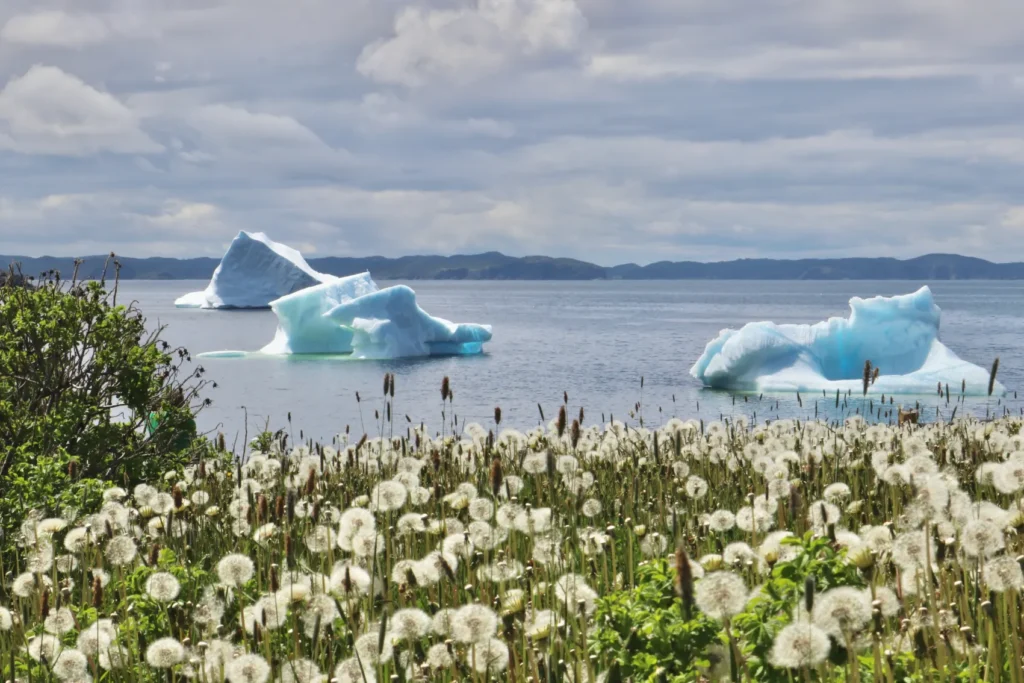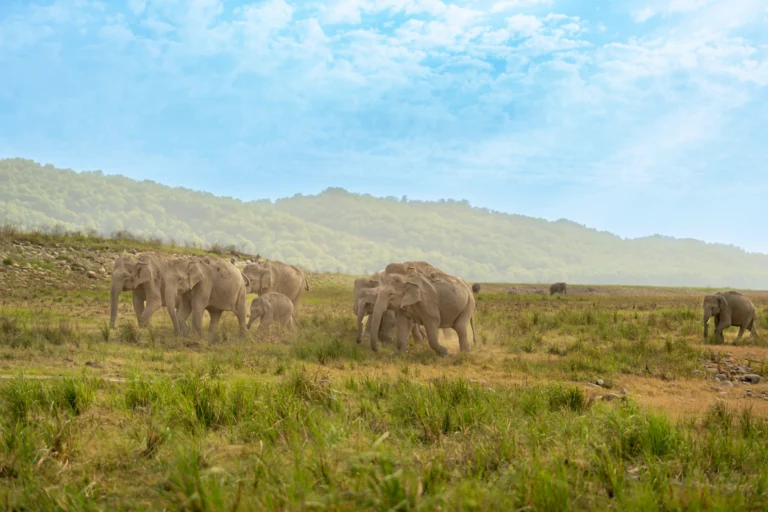
With its candy-tinted houses, spectacular national parks, and the sound of an Irish lilt in the air, Newfoundland and Labrador is an adventure lover’s paradise. Affectionately known as The Rock, this eastern Canadian province is home to some of North America’s oldest settlements and the first place on the continent to see the sunrise.
And with names like Ballyhack, Kilbride, and Cappahayden, you’d be forgiven for thinking your ferry took a wrong turn towards Ireland. Here’s everything you need to know if you’re planning to get screeched in on your Newfoundland and Labrador trip.
When’s the best time to visit?
The best time to go to Newfoundland depends on what you want to see and do. While the weather is famously unpredictable, conditions are generally more pleasant from May to October, when most festivals take place. If you’re there for the icebergs, plan your trip for late May to early June, when they’re most visible along the coast.
Newfoundland winter travel is totally possible, too. The snow-covered landscape is great for hiking, skiing, and cozying up in a warm bar in St. John’s. Nature lovers will love spring when the breeding season starts. It’s the ideal time to see brightly coloured puffins. And when the trees start turning colour in Autumn, the whole island becomes a photographer’s dream with its tapestry of changing leaves.

What is Newfoundland weather like?
Ask about the weather in Newfoundland and Labrador and you’ll probably get ‘unpredictable’ as a response. Summers are generally mild with average temperatures around 16°, although they can reach up to 25°. The freezing, snowy winters average around 0° but can dip down to -9°. But with the island’s wind chill, it often feels much colder.
Newfoundland sits where the cold Labrador current meets the warm Gulf Stream, which means you can expect quite a bit of rain, mist, and the occasional hurricane hitting coastal communities.
What should you pack?
With all that wind and rain in the forecast, you’re going to need some warm clothes. Even in summer, the weather can change quickly. The key is layering and making sure you’ve got a few essentials tucked into your pack. If you’re planning to explore the island’s many trails, a good pair of hiking boots is essential, along with warm, comfortable socks and a light waterproof jacket.
What is the best way to get to Newfoundland?
To travel to Newfoundland, you can fly or take the ferry or even cross the Atlantic on our Expedition ship from Iceland. Newfoundland might look small on the map, but the island is roughly the same size as Ireland. Most people arrive by plane, with direct flights into St. John’s, Gander, Deer Lake, Goose Bay, and Wabush. From Toronto, it’s about 3.5 hours to St. John’s, while flights from Calgary or Edmonton take around 6 hours. There are also seasonal international flights from London and other cities.
If you’re driving, Newfoundland ferry travel runs year-round from North Sydney, Nova Scotia, to Port aux Basques, and seasonally to Argentia, near St. John’s. The crossing takes 6 to 8 hours, depending on the weather.

And the best way to get around?
Unless you’re bringing your own or joining a small group tour (we’re very partial to the latter), a rental car is essential for exploring out-of-the-way locations in Newfoundland. But you do need to book well in advance, especially in peak season. RVs are a popular option too, with campsites scattered all over the island.
There’s also a public bus network connecting the larger towns. Don’t expect to take the train, though, the last railway shut down in 1988. Instead you can hike or cycle the Newfoundland T’Railway, once North America’s longest rail line, now a 883-km trail (549 mi) stretching from St. John’s to Port aux Basques — an ideal way to cross the island in your own time.
How much time do you need?
In a few days, you can visit St. John’s for a real taste of Newfoundland hospitality. If you’ve got a week or two, choose a few key spots and plan your route. Don’t be surprised if you’re pulled off course by a few unexpected beauty spots along the way. Ideally, give yourself a few weeks to appreciate the hiking trails, visit remote communities, and tackle national parks.

What is the most popular food?
If you want to try some traditional Newfoundland food, start with the pancake/doughnut-like toutons. A classic Jiggs Dinner of salt beef boiled with potatoes, cabbage, turnips, carrots, and split peas should be sampled at least once. And for dessert, a bakeapple pie, made with wild cloudberries, is a must.
Fresh seafood, like cod chowder, crab, and mussels, is everywhere, and some dishes reflect Indigenous traditions, especially those involving preserved fish and game. Inland, you’ll also find moose on the menu in everything from stews to burgers. Newfoundland food is flavourful, comforting and exactly what you need after a day hiking and adventure.
The best things to do in Newfoundland and Labrador
Jellybean Row, Iceberg Alley, and a good old-fashioned screech-in are just a few of the experiences waiting for you. Not to mention the seasonal whale or iceberg.
Spot puffins at Witless Bay
You’re spoiled for choice when it comes to spotting these clown-faced beauties. But Witless Bay Ecological Reserve is home to North America’s largest Atlantic puffin colony, with more than 260,000 pairs. Located just a 45-minute drive south of St. John’s, the best time to see the province’s official bird is from May to August.
The area is also a nesting site for thousands of other seabirds. The best way to see them up close is to book a boat tour around the offshore islands. While you’re there, continue south to Cape St. Mary’s Ecological Reserve, to see a massive colony of gannets, guillemots, and yes… more puffins. Walk out to Bird Rock for a close-up view without leaving dry land.

Watch whales breach in the bays
The bays of Newfoundland are one of the best places to go whale watching. Lying on their migration routes, the island’s waters attract the world’s largest population of humpback whales, along with minkes, fin whales, and even the occasional orca or dolphin.
You can spot them by boat, sea kayak, or shore from some of the best viewing spots at Signal Hill, Cape Bonavista, Witless Bay, and Twillingate. June and July are the best months to see whales, but you’ll have a good chance of seeing them any time between May and September.

Spot whales from the ship on: Across the North Atlantic: Iceland, Greenland & Labrador
Gaze as icebergs float by at Twillingate
Whales aren’t the only giants drifting through Newfoundland’s eastern waters. Twillingate, known as the “Iceberg Capital of the World,” is one of the top spots for iceberg viewing along Iceberg Alley, where towering chunks of glacier break off from Greenland and ride the current south.
The best month to see icebergs is May or June, and if you want to get up close, hop in a kayak or book a boat tour. Time it right and many tours combine puffin, whale, and iceberg watching for an unforgettable day on the water.
Plus, there’s more to Twillingate than just icebergs. Hike the Lower Head Trail taking in the iconic Long Point Lighthouse — one of the most photographed spots in Newfoundland, and some amazing clifftop views.

Scan for icebergs on: Newfoundland Adventure: From Deer Lake to St. John’s
Hike in Gros Morne National Park
If you’re here to hike, Gros Morne National Park is a must. This UNESCO World Heritage Site is full of mountains, fjords, and some cracking views. Walk across the Tablelands, and you’re literally stepping on the Earth’s mantle, a rare and barren landscape usually found way below the surface. And if you’re up for a challenge, tackle the 17km Gros Morne Mountain trail for epic views over the Long Range Mountains and Ten Mile Pond Gorge.
Other highlights include a fjord cruise past waterfalls on Western Brook Pond, or visiting the coastal towns of Norris Point and Rocky Harbour. Keep an eye out for moose and caribou amongst the park’s forests.

Traverse Tablelands on: Eastern Canada: Highlights of the Maritimes & Newfoundland
Roam the colourful streets of St. John’s
St. John’s is the capital of Newfoundland and Labrador and relatively small, making it easy to explore on foot. Wander past the brightly painted homes of Jellybean Row, guaranteed to brighten up the gloomiest of days. It’s worth staying for a few days so you can walk the local trails, see the sights, and enjoy the hospitality along George Street. There, you can get screeched in, a friendly tradition involving kissing a cod as a way to welcome visitors.
Pop into The Rooms, Newfoundland’s largest museum and art gallery, or explore the Colonial Building to read up on local history in one of Canada’s oldest cities.

Walk the trail to Signal Hill
Don’t miss a walk up to Signal Hill, the most visited spot in St. John’s. The North Head Trail takes you there with some brilliant views over the city and coastline on the way up.
At the top, you’ll find Cabot Tower, built to commemorate Queen Victoria’s Diamond Jubilee and John Cabot’s voyage. Stop in at the visitor centre to learn more about the site’s history, including its role in ancient battles and where the first wireless transatlantic signal was received. And as a bonus? The walk back into town is all downhill.

Learn about Labrador’s Inuit heritage
From the former Inuit community on the Labrador coast (and now a National Historic Site of Canada) in Hebron to the legislative capital where the Nunatsiavut Assembly meets in Hopedale, there are plenty of opportunities to learn about Inuit culture and life. As you trek the rugged coastlines or scan the frigid waters for copious wildlife, the experience is more meaningful with better understanding of the local people at the heart of the region’s aesthetic, historic, and cultural heritage.
Immerse in Inuit culture on: Across the North Atlantic: Iceland, Greenland & Labrador
See the sunrise at Cape Spear Lighthouse
Head about 20 minutes east of St. John’s, and you’ll reach Cape Spear, the easternmost point and home to the oldest lighthouse in Canada. Like many places along the coast of Newfoundland, you’ll have some pretty amazing views from here, and you might even spot a few minke whales just offshore. It’s worth visiting first thing in the morning to catch the first sunrise in North America. Just hang on to your hat, it can get a bit windy.

Explore the Bonavista Peninsula
Newfoundland is full of iconic lighthouses and Bonavista has one of its own. The town gets its name from the words “O Buona Vista!”, supposedly exclaimed by Italian explorer Giovanni Caboto when he first saw the land.
The town itself is a mix of old and new, and the surrounding peninsula is another fantastic spot for whale watching, puffin spotting, and the occasional iceberg sighting. This stretch of the island is part of a UNESCO Global Geopark, with sites tied to Newfoundland’s Mi’kmaq heritage and some fascinating geology going back over 500 million years. The area has plenty of trails, especially around nearby Trinity with scenic hikes like the Cape Shore Trail.

Make paths to puffins on: Newfoundland Adventure: From Signal Hill to Gros Morne
Take to the water at Gander Lake
Directly south of Twillingate, in the heart of Newfoundland, is Gander Lake, named after the geese who often drop by. It’s a favourite with outdoor enthusiasts thanks to year-round activities.
Known as a popular fishing spot along with the Gander River, it’s famous for its salmon and trout runs. Ideal for water sports, spend a day on the water kayaking, canoeing, or paddleboarding. And when winter rolls in, swap the paddles for ice fishing poles, or head into the nearby forests to explore on snowmobile or skis. The nearby towns of Glenwood or Gander are a handy base for your adventures, with the latter even having its own airport.
Take a gander at Gander on: Newfoundland Adventure: From Deer Lake to St. John’s
Lace up for the East Coast Trail
For the more adventurous, there’s a 336 km-long trail (208 mi) on the Avalon Peninsula, stretching from Topsail Beach in the north to Cappahayden in the south. It’s separated into 25 shorter trails, or you can hike the whole route in around 12–17 days, with six free campsites along the way.
This is a fantastic trail to experience Newfoundland at its wildest. You’ll pass through old communities, historic outports, and fishing settlements, many of which are still shaped by strong Irish and Indigenous roots.

Follow forest paths at Deer Lake
Just a half-hour drive from Gros Morne National Park, Deer Lake makes a great addition to your trip. With lakes, rivers, mountains, forests, and even a sandy beach in the middle of town, this family-friendly spot offers plenty.
It’s one of the best places to see moose and caribou, especially if you hit the scenic Humber Valley Trail. It’s also home to one of North America’s largest butterfly gardens. Deer Lake is also the ideal base for exploring further south into the Humber Valley and the Bay of Islands.
Explore nearby before heading on: Newfoundland Adventure: From Deer Lake to St. John’s
Celebrate the festivals in Newfoundland
During the summer, Newfoundland comes alive with festivals and events taking place all over the island. Even a walk down George Street in St. John’s puts you in the party mood. This is especially so on St. Patrick’s Day or during the George Street Festival in late July, where there’s live music in the bars and streets.
Other standout events include the Fish, Fun & Folk Festival in Twillingate, celebrating local culture each July, and the Roots, Rants & Roars culinary festival in Elliston every September, where top chefs showcase Newfoundland’s best food by the sea.
In May, Trails, Tales & Tunes takes over Gros Morne National Park, with hiking, storytelling, and live music in a setting that’s hard to beat. And for something a bit more offbeat, celebrate Newfoundland’s official bird at the Puffin Festival in Elliston.


